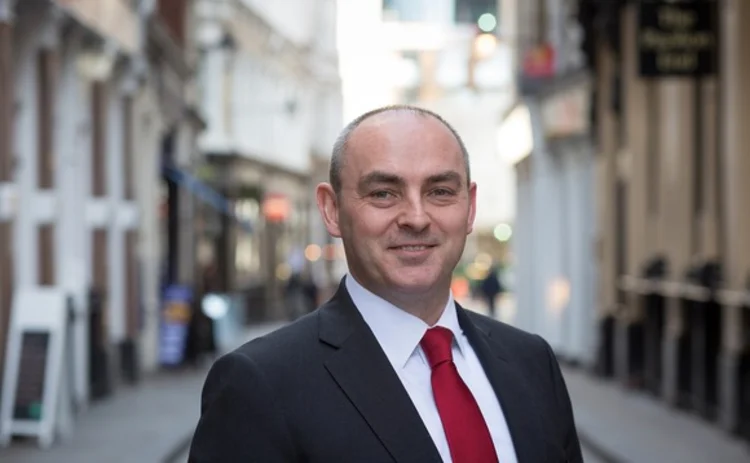Aberdeen's Iain Plunkett: Transformation Through Technology
Aberdeen Asset Management's new group CTO/COO discusses using technology as a lever for transformation.

When you enter the reception area of Aberdeen Asset Management’s headquarters, located around the corner from the iconic St. Paul’s Cathedral in London, you’re met with a glittering alcove stuffed with industry awards. While that’s not unusual—many firms display their accolades to visitors—the sheer volume of distinctions bestowed upon an asset manager just a little over 30 years old is impressive.
It denotes a dedication to continuous improvement, forward momentum and resilience in a market that has evolved drastically during the firm’s relatively short lifetime. Born of a management buy-out of an investment trust in 1983, Aberdeen has grown into one of the UK’s largest asset managers with £290.6 billion ($420 billion) in assets under management as of the first quarter of 2016, and the firm isn’t resting on its laurels.
Enter Iain Plunkett, Aberdeen’s group chief operating and technology officer, who joined the company in September 2015 before stepping up to his current role following the departure of the previous COO, Ken Fry, in January. Prior to joining, Plunkett had spent 15 years deep in the sell side, covering a range of senior positions at UBS and Barclays, before crossing the street to take the CTO/COO position with Aberdeen.
Plunkett explains that he was hired with a specific view in mind for the direction of the firm, a vision that starts with Martin Gilbert, the firm’s CEO. “Aberdeen needs to change its focus, to use technology as a key approach to innovation,” he says. “As a consequence, there was a decision to place technology as the driver of innovation at the group management board.”
Transformational Tech
“We need to start thinking about regulation in the same way that we create software and services. It needs to be in concert with the regulators, to become more experimentation-oriented and we need to be collaborative in a way that we have never been before. I think the whole industry would absolutely look to support a more agile model for regulation creation.”
Using technology as a lever for transformation has been a key theme throughout Plunkett’s career in financial services. At Aberdeen, he is now bringing these discussions to the top table as a board member, something he believes is occurring much more frequently among the asset management community.
“I think there is an inevitability to the role of technology in the sector,” he says. “Themes such as data, digital, how you can create commercial services with third parties, how fintech and the private equity space is driving dislocation—all of these key themes are board-level topics and actually relate directly to our competitiveness and strategy. Martin made, in my view, a strong statement of intent in appointing a CTO to the company’s group management board.”
Plunkett acknowledges that while technology is critical to both the operations of Aberdeen and that of the buy side in general, it is much more important than just building systems to fulfill one objective or as part of a wider strategy; it needs to be an all-encompassing philosophy at the heart of the business.
Instead of the traditional develop–deploy model, he says there should instead be an ecosystem that includes building and working in partnerships alongside the business, which leads to value-added outcomes that have a technology bias.
“We need to look at behaviors around collaboration, innovation, things like shorter cycles, experimentation, and attitudes toward risk—failing is fine; in fact, failing is the major route to learning as long as you don’t do it at scale,” he explains. “We as an organization don’t have the budgets like the large, universal banks, or the balance sheets for technology like the big vendors. But that gives us the opportunity to work within our ecosystem and supply chain to deliver value in new ways.”
Priorities
Aberdeen has historically had a globally minded operating model, built around its active equities business in the UK and US that raises assets to further its operations in emerging markets. However, the firm is now much more diversified than ever before—both in its geographic footprint and product offering—meaning building a solutions business, which is based on aggregating a myriad of different underlying products into an outcome-based strategy, is very diverse.
As such, the firm needs to be able to utilize a number of technology capacities to fulfill its ambitions for continued growth in its active equities and emerging market operations, and solutions business. Plunkett highlights a number of areas that he says are of vital significance to Aberdeen and the wider market, including predictive analytics and machine learning for insight generation into active equities, leveraging economies of the cloud for scalability, and agile development methodologies. (see page 12).
Plunkett says that while these areas are important, there is also “recognition that the buy side is not just a bunch of products that you install and try to make work together. It has to be around looking for more partnership opportunities, whether it is with fintech, our custodians or other people in the supply chain, but that commercial focus around technology and services is absolutely critical to the industry.”
At the heart of all technology is data, and this is the area that Plunkett says is critical, adding that the buy side, including hedge funds, are increasingly at war for private datasets. While data generally becomes wallpaper—i.e., freely available at the point of consumption—data owned by non-traditional data businesses will become a differentiator.
He points to new and relatively niche trends such as satellite imagery being used to generate footfall analysis at shopping malls to gain insight into parking lot fill ratios as a proxy for certain stores in their quarterly returns.
“Private data will become increasingly locked up with individual companies as a source of competitive advantage,” Plunkett explains. “This competition for data as an edge is happening already within hedge funds, but will increasingly apply to other buy-side firms.”
Agile Regulation
All capital markets players have to contend with changing regulations, and Aberdeen is no exception. The firm has created a small team to tackle any new regulations fed down the pipe, analyzing the workload in relation to individual segments of the business in order to create a funnel through which a suitable implementation can be achieved.
It’s an agile approach to a problem that has caused headaches for the buy side in recent years and Plunkett, given his experiences with the sell side during the 2008 credit crisis, believes the paradigm is here to stay for asset managers.
“Some of the regulatory provisions that were on the sell side post-2008—focusing on risk and stress testing—will likely end up applying more consistently and structurally to the buy side,” Plunkett says. However, he also points out that coping with regulatory demands could be eased through a move away from the traditional Waterfall method of introducing regulation—based on extensive documentation, contractual negotiations on implementation and long go-live timescales—into the market, as evidenced by the delays to the introduction of MiFID II in Europe.
“We need to start thinking about regulation in the same way that we create software and services,” he says. “It needs to be in concert with the regulators, to become more experimentation-oriented and we need to be collaborative in a way that we have never been before. I think the whole industry would absolutely look to support a more agile model for regulation creation.”
Past Lessons
The concept of agility is one that Plunkett has absorbed from his time at UBS and Barclays, among many others.
Plunkett joined UBS in 1999 after a five-year stint as a consultant at Accenture, where he had worked with the Swiss bank as a client, conducting what he describes as very technical work and learning how to use technology as a lever to transform businesses.
After joining UBS, Plunkett was responsible for running the investment banking department, mergers and acquisitions (M&A), primary debt and equity teams, which he says provided great insight into the investment process, although, as he jokes, it was something of a culture shock. “I was the only one who hadn’t gone to Oxbridge and I had this strange Scottish accent; they couldn’t pitch me, so I got away with it, to be honest,” he says.
This was during the heyday of the UBS investment banking business, where Plunkett found himself increasingly dealing with large-scale technology issues, like ripping out and replacing the back- and middle-office systems, building its wholesale cash business in Zurich, and running the business’ first cross-divisional strategy for building a wholesale cash framework for money markets and a cash clearing business.
“It was complex building a cross-cultural platform between Switzerland (the wealth and retail business) and the UK and US (the investment bank),” he recalls. “It was the first trial around creating utilities and I learned a lot of my lessons in life trying to make the UBS group come together to build services. We got it done in the end, but I learned a lot about creating teams, recognizing diversity and being able to work globally.”
These experiences set Plunkett in good stead when he was handed the managing director role in 2007, moving up to group managing director in 2012. By the time Plunkett left UBS in 2013 he was CIO for the investment bank’s global operations and had seen first-hand just how bad the 2008 credit crisis was, having rebuilt the bank’s risk controls in the wake of the damage.
Plunkett joined Barclays as the COO for group functions as the UK bank sought to emulate UBS’ corporate center model, creating a business unit of shared services. However, the project never took off as expected. A high rate of churn and lack of senior continuity meant Plunkett moved to the buy side in September 2015 after meeting Martin Gilbert and being impressed with the culture fostered at Aberdeen, “where people want to do the right thing for the firm.”
Following the departure of Fry as Aberdeen COO this past January, the decision to expand the role for Plunkett was central to the firm’s aim of making technology its main focal point. Plunkett says his banking experience will be useful in creating an efficient asset manager.
“The sell side is really complex; a lot of the bigger banks and firms have got so much technical debt, duplicative platforms and bad data that engineering out of it has been the bugbear since 2008,” he says. “What used to be the strength around getting product to market and doing it in a business-aligned fashion has become a real headwind in terms of complexity.”
Plunkett says that the while the buy side is in a more adventitious position, the agility of the sell side should be harnessed by asset managers to improve time to market, which is currently too slow to meet customer demand and often lacks in innovation.
“If I look across the buy side, most of them have created pretty streamlined platforms, they generally don’t have duplicate trading platforms, and they have a compliance framework and a mastery of data somewhere,” Plunkett explains. “The key challenge on the buy side is the flip of the sell side, which is how do you become more agile.”
Looking Forward
While it’s all well and good to have the benefits of hindsight, it’s how you utilize the knowledge going forward that’s vital. Plunkett acknowledges that Aberdeen faces some headwinds in the current market, particularly around automation.
“Our industry is inefficient in terms of processes and data, and we are no different,” he says. “Aberdeen’s numbers have historically always looked very efficient in relation to the top line, but if I look at the level of straight-through processing and the amount of manual intervention, I think the industry has not been built on an efficient model.”
Plunkett cites the sheer number of other players involved in the investment process—custodians, third-party administrators, numerous service providers, consultants and brokers—as a barrier to efficiency and a key talking point for himself and the firm. What he calls “hygiene factors,” such as automation tools, lean sigma, and good principles of data governance, are critically important to removing friction from Aberdeen’s supply chain.
While the headwinds Plunkett mentions are very real for both Aberdeen and the buy side in general, he says that the firm is using the opportunity to ensure it is leaner and more fit, that its platforms are ready for the next development stage, and it is well placed to capitalize on technology disruption in the market.
“It is early days but we can do a lot here as there is a real yearning to transform,” he says. “We are taking the opportunity to use innovation through technology as the means of supporting our diversification agenda.”
The appointment of Plunkett in the newly expanded group COO/CTO role for Aberdeen clearly indicates a drive to use technology as the primary transformative tool in what is already an impressive setup in its chosen markets. If he is able to utilize his sell-side experience to the fullest and bring real, substantial digital change to Aberdeen’s operations, then perhaps that award-laden window in the firm’s foyer will soon need to be expanded.
Iain Plunkett Fundamental Data
Name: Iain Plunkett
Title: Group chief operating and technology officer, Aberdeen Asset Management
Age: 44
Hometown: Glasgow
Current Residence: St. Albans
Education: B.Eng Information Engineering
Hobbies and Interests: Playing, coaching and watching sports; playing and listening to music; and family (married, two kids 5 and 7 years old)
Biggest Career Achievement: Creating many high-performing teams to solve highly complex and challenging business problems
Only users who have a paid subscription or are part of a corporate subscription are able to print or copy content.
To access these options, along with all other subscription benefits, please contact info@waterstechnology.com or view our subscription options here: https://subscriptions.waterstechnology.com/subscribe
You are currently unable to print this content. Please contact info@waterstechnology.com to find out more.
You are currently unable to copy this content. Please contact info@waterstechnology.com to find out more.
Copyright Infopro Digital Limited. All rights reserved.
As outlined in our terms and conditions, https://www.infopro-digital.com/terms-and-conditions/subscriptions/ (point 2.4), printing is limited to a single copy.
If you would like to purchase additional rights please email info@waterstechnology.com
Copyright Infopro Digital Limited. All rights reserved.
You may share this content using our article tools. As outlined in our terms and conditions, https://www.infopro-digital.com/terms-and-conditions/subscriptions/ (clause 2.4), an Authorised User may only make one copy of the materials for their own personal use. You must also comply with the restrictions in clause 2.5.
If you would like to purchase additional rights please email info@waterstechnology.com
More on Emerging Technologies
As trading firms embrace AI, so do hackers
According to a Google cybersecurity report, cybercriminals are turning to AI to sharpen their attacks.
AI & data enablement: A looming reality or pipe dream?
Waters Wrap: The promise of AI and agents is massive, and real-world success stories are trickling out. But Anthony notes that firms still need to be hyper-focused on getting the data foundation correct before adding layers.
Waters Wavelength Ep. 343: Broadridge’s Jason Birmingham
This week, Jason Birmingham of Broadridge talks with Tony about the importance of fundamentals as technology rapidly evolves.
Data standardization is the ‘trust accelerator’ for broader AI adoption
In this guest column, data product managers at Fitch Solutions explain AI’s impact on credit and investment risk management.
BNY inks AI deal with Google, Broadridge moves proxy voting to AWS, Expero delivers ICE market data, and more
The Waters Cooler: TSX Venture Exchange data hits the blockchain, SmartTrade acquires Kace, and garage doors link to cloud costs in this week’s news roundup.
Everyone wants to tokenize the assets. What about the data?
The IMD Wrap: With exchanges moving market data on-chain, Wei-Shen believes there’s a need to standardize licensing agreements.
Google, CME say they’ve proved cloud can support HFT—now what?
After demonstrating in September that ultra-low-latency trading can be facilitated in the cloud, the exchange and tech giant are hoping to see barriers to entry come down.
Waters Wavelength Ep. 342: LexisNexis Risk Solutions’ Sophie Lagouanelle
This week, Sophie Lagouanelle, chief product officer for financial crime compliance at LNRS, joins the podcast to discuss trends in the space moving into 2026.







